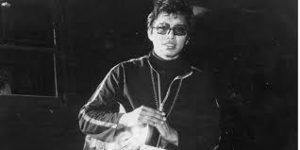
Sixto Rodriguez Biography
Sixto Diaz Rodriguez, also known as Rodriguez, was a Detroit, Michigan-born American singer-songwriter who was active from July 10, 1942, to August 8, 2023. Though his career began in the United States with minimal fanfare, he went on to find success in South Africa, Australia (where he made two previous trips), and New Zealand. His music was hugely popular and influential in South Africa, where he is thought to have sold more records than Elvis Presley, as well as other southern African nations, without his knowledge for many years. There was little information available about him, and a false story circulated that he had committed suicide not long after the release of his second album.
Dedicated South African admirers tracked out Rodriguez in the 1990s and got in touch with him, which resulted in an unexpected resurgence of his musical career. This story, which won the 2012 Academy Award for best documentary, Searching for Sugar Man, also helped Rodriguez gain some notoriety in his own country. From his alma mater, Wayne State University in Detroit, Rodriguez received an honorary Doctor of Humane Letters degree in May 2013.
Rodriguez was filmed in Searching for Sugar Man strolling through Detroit’s historic Woodbridge neighborhood, where he resided. He led a basic existence without a phone and occasionally frequented establishments like the Old Miami tavern in Detroit’s Cass Corridor neighborhood near Woodbridge and Midtown, where he gave tiny local audiences live performances.

Sixto Diaz Rodriguez Early life
On July 10, 1942, Sixto Diaz Rodriguez was born in Detroit, Michigan. He was the sixth child of working-class Mexican immigrants. Since he was their sixth child, they gave him the name Sixto (pronounced “Seex-toh”). His mother was Native American, and his father had immigrated to the US from Mexico in the 1920s. They had come to the Midwest to work in Detroit’s industries, joining a huge wave of Mexican immigrants. At that time, Mexican immigrants experienced extreme marginalization and estrangement. Rodriguez frequently expresses his political views in his songs about the struggles experienced by the poor in inner cities.

Sixto Rodriguez’s Nationality
American citizen Sixto Rodriguez was born in Detroit, Michigan.
Sixto Rodriguez’s Net Worth
The $5 million fortune of American guitarist Sixto Rodriguez.
Sixto Rodriguez’s Height & Weight
Sixto Rodriguez is 70 kilograms and 6 feet tall.
Sixto Rodriguez’s Marital Status
Konny Rodriguez was the husband of Sito Rodriguez. As Rodriguez’s second wife, Konny Rodriguez is best known for their 1984 wedding. When they were both students at Detroit’s Wayne State University in 1972, according to Konny Rodriguez and Sixto Rodriguez, they fell in love and got married in the early 1980s.
Sixto Rodriguez’s Family & Siblings
The sixth child of working-class Mexican immigrants, Sixto Diaz Rodriguez was born in Detroit, Michigan. Since he was their sixth child, they gave him the name Sixto (pronounced “Seex-toh”).
His mother is Native American, while his father moved to the United States from Mexico in the 1920s. They joined the massive flood of Mexicans that had already arrived in the Midwest to work in the factories of Detroit.

Sixto Rodriguez’s Children
Sandra, Eva, and Regan are the last three daughters of Sixto Rodriguez.
Eva Rodriguez, who is 60 years old and was born on February 4, 1963, is thought to be Sixto Rodriguez’s oldest child. She is allegedly a set decorator, but as she avoids the media and keeps her personal life private, little is known about her personal life.
Regan Rodriguez, who appears in the films Dead Men Don’t Tour: Rodriguez in South Africa (1998), Searching for Sugar Man (2012), and 60 Minutes (1968), is thought to be Sixto Rodriguez’s third child. She has kept her private life out of the media, just like her sister has.
Sandra Rodriguez-Kennedy is thought to be Sixto Rodriguez’s second child. In the film Dead Men Don’t Tour: Rodriguez in South Africa, she made an appearance.
Sixto Rodriguez’s Social Media
Since there is no handle that can be used to identify him, Sixto Rodriguez appears to not be using any social media sites.

Sixto Diaz Rodriguez Recording career
He recorded the single “I’ll Slip Away” in 1967 on the tiny Impact label under the alias “Rod Riguez” (a moniker bestowed upon him by his record company). Before signing with Sussex Records, a division of Buddah Records, he went three years without making another recording. After then, he went by his preferred business name, “Rodriguez”. He collaborated with Sussex on two albums: Cold Fact from 1970 and Coming from Reality from 1971. Both, though, had little success in the United States, and Sussex, which had already shut down in 1975, immediately abandoned him. He was working on a third album at the time he was fired, but it was never made public.
Rodriguez ended his musical career and, for $50 (US$257 in 2022 dollars), bought a run-down Detroit home at a government auction in 1976. As of 2013, he was still residing there. He always made a meager living working on production lines and doing demolition. In order to better the lives of the city’s working-class citizens, he continued to be politically engaged and made many unsuccessful runs for public office, including in 1989 for the Detroit City Council, in 1981 and 1993 for mayor of Detroit, and in 2000 for the Michigan House of Representatives.
It was revealed in 2013 that Rodriguez and Steve Rowland, who worked on his Coming From Reality album, were in communication. According to Rodriguez, “I’ve written about thirty new songs,” Rolling Stone. “He instructed me to send him a few tapes, therefore I will do that. He’s now bursting with ideas, so I definitely want to look him up.
Despite the fact that Rodriguez was largely unknown in his own nation, by the middle of the 1970s, his recordings were beginning to receive a lot of airtime in countries like Australia, Botswana, New Zealand, Rhodesia, and South Africa.
Australian record company Blue Goose Music purchased the Australian rights to his records after the imported copies of his Sussex LPs went out of print. Blue Goose issued his two studio albums as well as the compilation CD At His Best, which contained three previously unreleased songs from 1973: “Can’t Get Away,” “I’ll Slip Away” (a re-record of his first hit), and “Street Boy”.
At His Best achieved platinum status in South Africa, which once served as the world’s primary disc-pressing market for his music. During his lifetime, Rodriguez was compared to artists like Bob Dylan and Cat Stevens. Many of his songs have anti-establishment themes, which helped South Africa’s anti-apartheid protest culture. His work had a significant impact on the music scene at the time as well as a generation that was drafted, largely against their will, into the country’s then-whites-only military. According to rumors, Steve Biko, an anti-apartheid activist, was an admirer of Rodriguez.
In 1979 and 1981, Rodriguez conducted two concert tours across Australia, where he was also successful.
Both of his albums were initially made available on CD in South Africa in 1991, which contributed to the longevity of his notoriety. Fans didn’t know much about his life, though, and there were rumors that he had committed suicide in the 1970s while performing.
Despite his success abroad, Rodriguez was unaware of his fame in South Africa until his eldest daughter, Eva, stumbled across a website devoted to him in 1997. Rodriguez embarked on his first South African tour, performing six performances in front of tens of thousands of fans, after getting in touch with the website and learning about his reputation there. Rodriguez in South Africa, 1998, a documentary, was broadcast on SABC TV in 2001. Before making his return to South Africa in 2001 and 2005, he also gave a performance in Sweden.

The South African rock group Just Jinger and the Scottish musician Paolo Nutini both covered Rodriguez’s signature song, “Sugar Man,” in 1998. Rodriguez received further international radio when disc jockey David Holmes featured it as the opening track for his mix album Come Get It I Got It in 2002. As a result of being sampled in the song “You’re Da Man” from rapper Nas’ 2001 album Stillmatic, “Sugar Man” earlier attained even greater prominence.
He visited Australia again in April 2007 and 2010 to perform at the East Coast Blues & Roots Music Festival and for sold-out performances in Adelaide, Melbourne, and Sydney. In the Heath Ledger-starring 2006 movie Candy, his song “Sugar Man” was used. For his third studio album, singer-songwriter Ruarri Joseph adapted Rodriguez’s song “Rich Folks Hoax”. The 2020 song “Lost Dog Loyal” by Irish singer-songwriter Darragh O’Dea makes reference to “Inner City Blues” and mentions Rodriguez. Later in life, Rodriguez carried on his international tour.
Light in the Attic Records reissued Rodriguez’s albums Cold Fact and Coming from Reality in 2009.
Rodriguez’s song “Hate Street Dialogue” initially appeared on his album Cold Fact. In 2014, French deep house and electro music producer The Avener produced a new version of the song. Rodriguez’s vocals are featured in The Avener’s rendition. The song reached the French charts.
Searching for Sugar Man
The documentary Searching for Sugar Man, directed by Swedish filmmaker Malik Bendjelloul, had its world premiere at the Sundance Film Festival in 2012. It follows two South African admirers as they try to find out whether the musician’s supposed demise is real and, if not, what happened to him. The documentary, which was created by Simon Chinn and John Battsek, later took home the World Cinema Audience Award and Special Jury Prize.

The movie premiered on July 27, 2012, in New York and Los Angeles, as well as at other film festivals, such as the True/False Film Festival and the Traverse City Film Festival, before a longer domestic theatrical run. During the summer of 2012, it was also shown as a part of the cinematic offerings at a few European music festivals, such as the Way Out West festival in August, where Rodriguez gave a performance. It earned the Best Music Documentary Award and the Audience Award at the Amsterdam International Documentary Film Festival in November.
Rodriguez’s Cold Fact and Coming from Reality albums as well as three unheard songs from his third unfinished album are all included in the soundtrack for the movie Searching for Sugar Man. The CD was made available on July 24, 2012. The back cover of the album states, “Rodriguez receives royalties from the sale of this release,” which should calm any worries that could have been caused by the movie’s depiction of Rodriguez being allegedly taken advantage of by his prior record label.
On February 10, 2013, Searching for Sugar Man received the BAFTA Award for Best Documentary.
On January 13, 2013, Searching for Sugar Man received an Oscar nomination for Best Documentary Feature; on February 24, 2013, it was announced as the winner. Rodriguez chose not to go to the award ceremony so as not to diminish the accomplishment of the filmmakers. Chinn said on such generosity after receiving his prize, “That just about says everything about that man and his story that you want to know.” And on stage, Malik Bendjelloul added, “Thanks to one of the greatest singers ever, Rodriguez.”

Belated success in the United States
Following the cinematic debut of Searching for Sugar Man in 2012, Rodriguez had a surge in media attention and audience engagement in both the US and Europe. On August 14, 2012, he performed “Crucify Your Mind” as a musical guest on the Late Show with David Letterman, and on January 11, 2013, he sang “Can’t Get Away” on The Tonight Show with Jay Leno.
Important news coverage includes a CNN feature article from mid-August 2012 where Rodriguez was interviewed on his life and career comeback. Rodriguez was a featured guest on the American television news show 60 Minutes on October 7, 2012. Rodriguez was interviewed on The Andrew Marr Show, a Sunday morning news program in the UK, on November 18, 2012, and he also sang a little song over the show’s closing credits. On November 16, 2012, he gave a performance and was interviewed by Jools Holland on the BBC2 program Later… with Jools Holland. He has performed on web programs like The Weekly Comet on the internet.
Searching for Sugar Man, a movie strongly suggests that Clarence Avant, in particular, may have defrauded Rodriguez of royalties throughout the years. The legal concerns in this case are significant, and the inquiry is still ongoing. The “symbols of success” initially piqued Rodriguez’s disinterest, but he later brought legal action in 2013. The litigation was said to have been resolved in 2015, but no financial details were made public.
His most well-attended U.S. performances to date, such as a run at the Beacon Theatre in New York City in April and a spot at the 2014 Sasquatch Music Festival at The Gorge Amphitheatre, as well as other concerts in Europe, were all part of Rodriguez’s tour schedule for 2013 in addition to performances in Australia, South Africa, and New Zealand. In June 2013, he performed on the Park Stage at the Glastonbury Festival in the UK. Rodriguez kicked off the 2013 Montreux Jazz Festival on July 5. He performed as the headlining act at the UK’s Wilderness Festival on August 10, 2013. In 2015, he served as the opening act for Brian Wilson’s tour with Blondie Chaplin, Al Jardine, and Wilson of the Beach Boys.
Given that the Dave Matthews Band frequently covered “Sugar Man” during their summer tour, Rodriguez gained more publicity in 2014. Matthews would frequently introduce the song by talking about how he first became a fan of Rodriguez while growing up in South Africa and how surprised he was that Rodriguez wasn’t more well-known in the US.
Sixto Diaz Rodriguez Later activity
A book titled Sugar Man: The Life, Death, and Resurrection of Sixto Rodriguez was published in 2015 by Craig Bartholomew Strydom and Stephen “Sugar” Segerman. The book was described as “probably one of the most unusual rock ‘n roll stories out there” in a Business Day review.
Rodriguez most recently visited Canada and the US in 2018. In August 2018, he led a tour that culminated with a performance in his hometown at Detroit’s Garden Theater.
An Outlook on the BBC World Service broadcast from 2022 focused on Rodriguez and the process of his rediscovery.
Sixto Diaz Rodriguez Death
On August 8, 2023, Rodriguez passed away at the age of 81. His cause of death was not made known to the public.

Where is Sixto Rodriguez from?
Detroit, Michigan’s capital and largest city, is where Sixto Rodriguez hails from. The Detroit Industry Murals, created by Diego Rivera and inspired by the city’s connections to the car industry, which gave it the moniker “Motor City,” are a famous attraction at the neoclassical Detroit Institute of Arts, located close to Downtown.
How old is Sixto Rodriguez?
Sixto Rodriguez, born on July 10, 1942, passed away at the age of 81.
Why is Sixto Rodriguez famous?
The Oscar-winning documentary “Searching for Sugarman” by Sixto Rodriguez is well-known.
Where was Sixto Rodriguez born?
American singer-songwriter Sixto Diaz Rodriguez, better known by his stage name Rodriguez, was born in Detroit, Michigan on July 10, 1942.
Does Sixto Rodriguez have children?
Sandra, Eva, and Regan are the last three daughters of Sixto Rodriguez. Eva Rodriguez, who is 60 years old and was born on February 4, 1963, is thought to be Sixto Rodriguez’s oldest child. She is allegedly a set decorator, but she has kept her private life private, therefore little is known about her personal life.

Who is Sixto Rodriguez wife?
According to his wife Konny Rodriguez, 72, he passed away after a brief illness.
Where did Sixto Rodriguez live?
Despite the fact that Rodriguez’s music was so well-liked throughout the nation, nothing was known about him, and untrue rumors that he had committed suicide on stage in the 1970s were circulating. However, Rodriguez had returned to a life of relative obscurity and construction work, and was in reality still alive and well in Detroit.
Discover more from Labaran Yau
Subscribe to get the latest posts sent to your email.



















